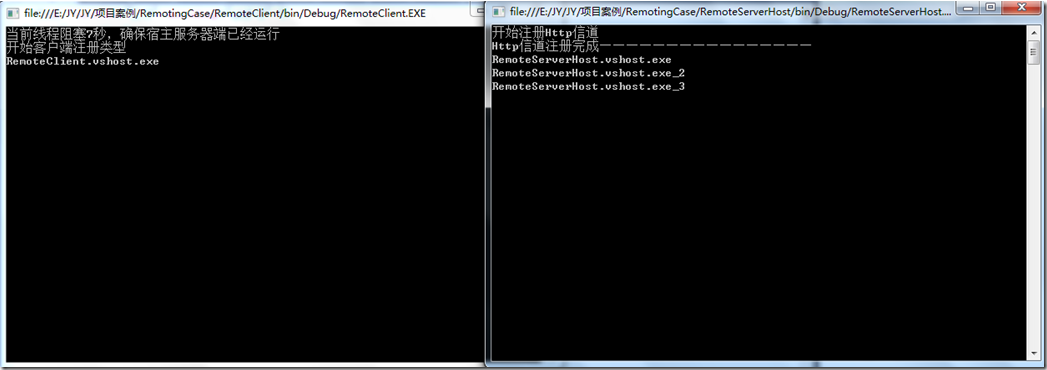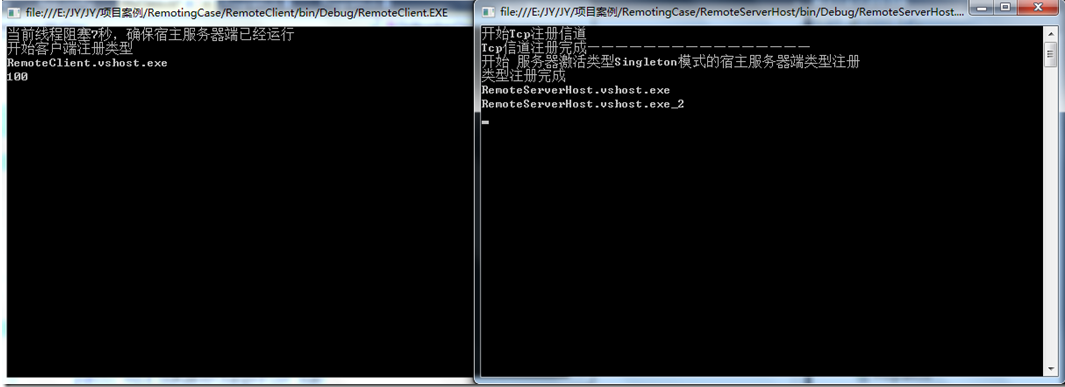.Net组件程序设计之远程调用(二)
激活模式
引用封送对象激活类型两种,
一种是客户端激活类型,一种是服务器端激活.
客户端激活对象
客户端激活方式:当客户端创建一个远程对象时,客户端得到的是一个新的实例引用,新的实例可以在内存中维持状态,并且可以使用参数化构造函数来激活远程对象。
服务器激活模式single-call
SingleCall激活方式:当客户端使用一个服务器激活方式为SingleCall的对象时,.NET为每个方法调用创建一个新对象,在方法执行完毕后,对象则被销毁,客户端虽然维持着对远程对象的引用,但是真实对象已经被销毁了。
服务器激活Singleton
Singleton激活方式:所有客户端共享一个远程对象。
下面为大家演示几段示例,就详细的清楚每一种激活方式的作用了。
1 using System.Runtime.Remoting; 2 using System.Runtime.Remoting.Messaging; 3 namespace RemoteServer 4 /// <summary> 5 /// 服务端 6 /// </summary> 7 public class MyClass : MarshalByRefObject 8 { 9 public MyClass() 10 { 11 _count++; 12 string mes = AppDomain.CurrentDomain.FriendlyName; 13 Console.WriteLine(mes); 14 } 15 16 private int _count = 0; 17 18 public event EventHandler NumberChanged; 19 20 public void Count() 21 { 22 _count++; 23 Console.WriteLine(AppDomain.CurrentDomain.FriendlyName + "_" + _count.ToString()); 24 } 25 26 public void OnNumberChanged(int num) 27 { 28 if (NumberChanged != null) 29 { 30 NumberChanged(num, null); 31 } 32 } 33 } 34 35 public class EventMehtodClass : MarshalByRefObject 36 { 37 [OneWay] 38 public void OnNumberChanged(object sender, EventArgs e) 39 { 40 if (sender != null) 41 { 42 Console.WriteLine(sender.ToString()); 43 } 44 } 45 }
1 宿主服务端(服务器端) 2 using System.Runtime.Remoting; 3 using System.Runtime.Remoting.Channels; 4 using System.Runtime.Remoting.Channels.Http; 5 using System.Runtime.Remoting.Channels.Tcp; 6 using System.Runtime.Remoting.Channels.Ipc; 7 using System.Runtime.Remoting.Services; 8 using RemoteServer; 9 10 namespace RemoteServerHost 11 12 #region 编程式 宿主服务端注册 信道和对象类型 13 Console.WriteLine("开始Tcp注册信道"); 14 IChannel tcpChannel = new TcpChannel(8003); 15 ChannelServices.RegisterChannel(tcpChannel, false);//注册Tcp类型信道 16 Console.WriteLine("Tcp信道注册完成————————————————"); 17 Console.WriteLine("开始 服务器激活类型SingleCall模式的宿主服务器端类型注册"); 18 RemotingConfiguration.RegisterWellKnownServiceType(typeof(MyClass), "RWCTmyclass",WellKnownObjectMode.SingleCall); 19 Console.WriteLine("类型注册完成"); 20 #endregion 21 22 Thread.Sleep(new TimeSpan(0, 2, 0)); 23 Console.WriteLine("释放Tcp信道"); 24 ChannelServices.UnregisterChannel(tcpChannel);
这里所用的激活方式是 服务器SingleCall激活方式,通过RemotingConfiguration.RegisterWellKnownServiceType()方法来注册类型,第二个参数为统一资源标识符(URI),很好理解就是字面的意思,远程对象就是资源,标识资源的一个符号(名称),有了它,客户端在调用远程对象的时候才知道具体在哪。因为是服务器激活方式所以URI是在包含在注册类型的方法中的,而如果是客户端激活类型注册的话,则使用RemotingConfiguration.RegisterActivatedServiceType(typeof(MyClass));
有的朋友会问了,这样统一资源标识符不是没设置吗?是的,确实没有设置,客户端激活类型注册的时候URI是这样设置
1 RemotingConfiguration.ApplicationName = "RWCTmyclass";
1 客户端(调用端) 2 using System.Runtime.Remoting; 3 using System.Runtime.Remoting.Channels; 4 using System.Runtime.Remoting.Channels.Http; 5 using System.Runtime.Remoting.Channels.Tcp; 6 using System.Runtime.Remoting.Channels.Ipc; 7 using System.Runtime.Remoting.Services; 8 using RemoteServer; 9 10 namespace RemoteClient 11 12 #region 编程式本地注册 13 Thread.Sleep(new TimeSpan(0, 0, 7));//便于调,使当前客户端线程阻塞7秒,确保宿主服务端已经运行 14 string url = "tcp://localhost:8003/RWCTmyclass"; 15 Console.WriteLine("开始客户端注册类型"); 16 RemotingConfiguration.RegisterWellKnownClientType(typeof(MyClass), url); 17 #endregion 18 19 20 //类型使用 21 MyClass myclass = new MyClass(); 22 myclass.Count(); 23 MyClass myclass1 = new MyClass(); 24 myclass1.Count();
图 1

因为这里使用的是服务器SingleCall类型模式激活的,所以对象状态是不保存的,就跟上面那一小节定义的一样,只有在方法调用的时候才会被创建,方法调用完毕则会被释放销毁,但是也可以在宿主服务端使用变量来记录状态。现在可以在宿主服务端(服务器端)注册类型的时候把激活模式换成Singleton的再来看一下结果:
这是编程式的示例代码,下面给大家演示配置式的。
1 宿主服务端(服务器端) 2 using System.Runtime.Remoting; 3 using System.Runtime.Remoting.Channels; 4 using System.Runtime.Remoting.Channels.Http; 5 using System.Runtime.Remoting.Channels.Tcp; 6 using System.Runtime.Remoting.Channels.Ipc; 7 using System.Runtime.Remoting.Services; 8 9 using System.Threading; 10 11 using RemoteServer; 12 13 namespace RemoteServerHost 14 15 #region 配置式宿主服务端注册 信道和对象类型 16 Console.WriteLine("开始注册Http信道"); 17 RemotingConfiguration.Configure(AppDomain.CurrentDomain.FriendlyName + ".config"); 18 Console.WriteLine("Http信道注册完成————————————————"); 19 #endregion
这里只要使用.NET给我们提供的RemotingConfiguration类型中的Configure()方法来加载配置文件就行了,注册信道的类型,远程对象的激活方式和模式都是在配置文件中注册的,来看配置文件信息:
1 <?xml version="1.0" encoding="utf-8" ?> 2 <configuration> 3 <system.runtime.remoting> 4 <application> 5 <channels> 6 <channel ref="http" port="8004"/> 7 </channels> 8 <service> 9 <wellknown mode="Singleton" type="RemoteServer.MyClass,RemoteServer" objectUri="RTMyClass" /> 10 </service> 11 </application> 12 </system.runtime.remoting> 13 </configuration>
这里配置文件中,是准备注册http类型的信道,并且把远程对象注册为服务器激活类型(wellKnow)Singleton激活模式,宿主服务端的就这么多,接下来看客户端的.
1 客户端 2 using System.Runtime.Remoting; 3 using System.Runtime.Remoting.Channels; 4 using System.Runtime.Remoting.Channels.Http; 5 using System.Runtime.Remoting.Channels.Tcp; 6 using System.Runtime.Remoting.Channels.Ipc; 7 using System.Runtime.Remoting.Services; 8 9 using System.Threading; 10 11 using RemoteServer; 12 13 namespace RemoteClient 14 15 #region 配置式本地注册 16 Thread.Sleep(new TimeSpan(0, 0, 7)); 17 Console.WriteLine("开始客户端注册类型"); 18 RemotingConfiguration.Configure(AppDomain.CurrentDomain.FriendlyName + ".config", false); 19 #endregion 20 //类型使用 21 Console.WriteLine(AppDomain.CurrentDomain.FriendlyName); 22 MyClass myclass = new MyClass(); 23 myclass.Count(); 24 MyClass myclass1 = new MyClass(); 25 myclass1.Count();
跟宿主服务端的一样,使用Configure()方法来注册远程对象,但是本地的配置文件怎么配置呢?不着急的,一起来看:
1 <?xml version="1.0" encoding="utf-8" ?> 2 <configuration> 3 <system.runtime.remoting> 4 <application> 5 <client> 6 <wellknown type="RemoteServer.MyClass,RemoteServer" url="http://localhost:8004/RTMyClass"/> 7 </client> 8 </application> 9 </system.runtime.remoting> 10 </configuration>
客户端 要注册的 远程对象类型 的 激活类型(客户端激活、服务器端激活) 是要跟宿主服务端的相对应。
这次换了Singleton模式
图2

1 宿主服务端: 2 using System.Runtime.Remoting; 3 using System.Runtime.Remoting.Channels; 4 using System.Runtime.Remoting.Channels.Http; 5 using System.Runtime.Remoting.Channels.Tcp; 6 using System.Runtime.Remoting.Channels.Ipc; 7 using System.Runtime.Remoting.Services; 8 using System.Threading; 9 10 using RemoteServer; 11 namespace RemoteServerHost 12 13 14 #region 远程回调 15 Console.WriteLine("开始Tcp注册信道"); 16 BinaryServerFormatterSinkProvider formatter = new BinaryServerFormatterSinkProvider();//二进制格式化器 17 formatter.TypeFilterLevel = System.Runtime.Serialization.Formatters.TypeFilterLevel.Full;//设置过滤类型为Full 18 19 IDictionary channel = new Hashtable(); 20 channel["name"] = "RWCTmyclass"; 21 channel["port"] = 8003; 22 23 IChannel tcpChannel = new TcpChannel(channel, null, formatter); 24 ChannelServices.RegisterChannel(tcpChannel, false);//注册Tcp类型信道 25 Console.WriteLine("Tcp信道注册完成————————————————"); 26 Console.WriteLine("开始 服务器激活类型Singleleton模式的宿主服务器端类型注册"); 27 RemotingConfiguration.RegisterWellKnownServiceType(typeof(MyClass), "RWCTmyclass", WellKnownObjectMode.Singleton); 28 Console.WriteLine("类型注册完成"); 29 #endregion 30 31 32 Thread.Sleep(new TimeSpan(0, 2, 0)); 33 34 Console.WriteLine("释放Tcp信道"); 35 ChannelServices.UnregisterChannel(tcpChannel);
1 客户端: 2 3 using System.Runtime.Remoting; 4 using System.Runtime.Remoting.Channels; 5 using System.Runtime.Remoting.Channels.Http; 6 using System.Runtime.Remoting.Channels.Tcp; 7 using System.Runtime.Remoting.Channels.Ipc; 8 using System.Runtime.Remoting.Services; 9 10 using System.Threading; 11 12 using RemoteServer; 13 14 namespace RemoteClient 15 16 17 #region 远程回调 18 Thread.Sleep(new TimeSpan(0, 0, 7)); 19 IChannel tcp = new TcpChannel(0); 20 ChannelServices.RegisterChannel(tcp, false); 21 string url = "tcp://localhost:8003/RWCTmyclass"; 22 Console.WriteLine("开始客户端注册类型"); 23 RemotingConfiguration.RegisterWellKnownClientType(typeof(MyClass), url); 24 #endregion 25 26 Console.WriteLine(AppDomain.CurrentDomain.FriendlyName); 27 MyClass myclass = new MyClass(); 28 myclass.Count(); 29 EventMehtodClass methodclass = new EventMehtodClass(); 30 myclass.NumberChanged += methodclass.OnNumberChanged; 31 Thread.Sleep(100); 32 myclass.OnNumberChanged(100);
图-3

在Singleton激活方式下是可以完成远程回调的,但是用Singlecall模式的话则不行,因为如果是这样的话,之前对远程对象(服务器对象)的操作都没有状态保存,上面说到过,Singlecall模式是一来一回则被释放掉了,本地客户端仅仅是保留了一个代理。可以验证一下:
修改宿主服务端的代码Singleton改为SingleCall
1 RemotingConfiguration.RegisterWellKnownServiceType(typeof(MyClass), "RWCTmyclass", WellKnownObjectMode.SingleCall);
修改客户端的代码 myclass.Count();又新加一句
1 MyClass myclass = new MyClass(); 2 myclass.Count(); 3 myclass.Count(); 4 EventMehtodClass methodclass = new EventMehtodClass(); 5 myclass.NumberChanged += methodclass.OnNumberChanged; 6 Thread.Sleep(100); 7 myclass.OnNumberChanged(100);
修改后的运行结果:
图4

为什么没有像图1中的那样发生回调这里已经不用说明了。
作者:金源
出处:http://www.cnblogs.com/jin-yuan/
本文版权归作者和博客园共有,欢迎转载,但未经作者同意必须保留此段声明,且在文章页面